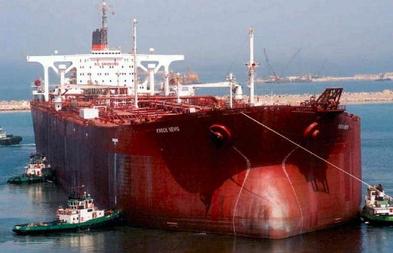We noted Euronav's purchase of their second of two remaining Ultra Large Crude Carriers back in 2018. Here's it's partner, the slightly smaller* TI Europe:

File photo shows the ULCC TI Europe, one of two 3 million barrel capacity oil tankers currently in the world. Photo: Euronav
*441585 DWT vs
441561 DWTMore on them after the jump.
Like most of the group, the tanker fleets are not in overwhelming demand at the moment what with recession in some countries and slowing economies in others but they seem to be looking ahead to good times with Frontline in particular showing strength and Euronav on the cusp of breaking out of a downtrend:
And from gCaptain:
Euronav Storing Initial Supply of IMO 2020-Compliant Fuel On Board ULCC Oceania
Belgian tanker owner Euronav says it has so far procured 420,000 metric tons of low sulphur fuel oil which is storing aboard one of its ultra large crude carriers in preparation of the IMO 2020 fuel regulations.No word on if Euronave wants to make the bunkering operation permanent, in which case Oceania would join her cousins TI Asia and TI Africa as a Floating, Storage and Offloading (FSO) vessel.
The company made the disclosure on Thursday along with additional details about its plan to comply with the upcoming low sulphur fuel regulations.
Euronav says the average price paid for the IMO 2020-compliant fuel amounts to $447 per metric ton, compared to the $447 per metric ton average it paid for high sulphur fuel during the same period.
The company said to help it prepare for the January 1 deadline, it has established a dedicated fuel procurement team that will procure, test, and store the new Very Low Sulphur Fuel Oil, or VLSFO, for its own use.
To store the VLSFO it has purchased, Euronav is currently using one of its two Ultra Large Crude Carriers (ULCC), the Oceania, which will reposition to later this month. Euronav’s other ULCC, the Europa, is currently under commercial time charter until the end of 2019.
Finally, Euronav says it has also secured an additional $100 million in financing for fuel procurement.....MORE
The Oceania can carry 3.1 million barrels which may account for the excellent pricing EURN received on their purchase.
And back to that 2018 post:
Euronav Just Bought the Second of Two Very-Ultra-Supertankers Left In the World
You landlubbers can't deny
That when a ship sails in with an itty, bitty tug
And a round thing in your....ahem...don't know where that came from, moving on....
*****
.....Big yes but still nothing like the ones the Japanese and French built back in the day.
From February's Big Boats: "Switzerland's Allseas plans world's largest construction vessel"
...Pioneering Spirit measures 382 x 124 meters and is calculated at 403,342 gross tonnage. Note that gross tonnage is a calculation of enclosed volume times a multiplier and is not deadweight tonnage.
For that measure we go back to a different 2017 post, "Frontline Boss On Oil: "Fredriksen Expects Rise In Storage Of Oil On Tankers" (FRO)":
...Whenever you see the market with enough contango to make the cash-and-carry storage trade worthwhile I think of this sucker (now broken for scrap):

Built by Sumitomo
Capacity: 4,240,865 barrels o'crude.
From the Wikipedia page:
Seawise Giant, later Happy Giant, Jahre Viking, Knock Nevis, Oppama, and finally Mont, was a ULCC supertanker that was the longest ship ever built. It possessed the greatest deadweight tonnage ever recorded. Fully loaded, its displacement was 657,019 tonnes (646,642 long tons; 724,239 short tons), the heaviest ship of any kind, and with a laden draft of 24.6 m (81 ft), it was incapable of navigating the English Channel, the Suez Canal or the Panama Canal. Overall, it was generally considered the largest ship ever built. It was sunk during the Iran–Iraq War, but was later salvaged and restored to service. It was last used as a floating storage and offloading unit (FSO) moored off the coast of Qatar in the Persian Gulf at the Al Shaheen Oil Field....MOREHere's how it stacked up against some other big boats (and buildings):...
And in a third measurement of size, January 2014's:
Natural Gas: Shell Launches The Largest Vessel Ever Built (displacement larger than six aircraft carriers) RDS
And we're not talking little French aircraft carriers either.
From Lloyd's:
Lloyd's covers largest ever floating vessel...
*****
... Giving the French their due, they are planning on building Porte-Avions 2 - "aircraft carrier 2", using the plans for the future Queen Elizabeth class ships that perfidious Albion is cooking up.
Project Canceled, 15 July 2013
And again giving the French a tip of the old chapeau they did build these monsters:

Batillus class tanker, 555,000 DWT.